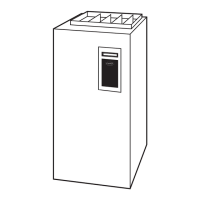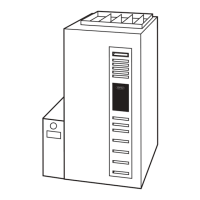CPU before the 25-sec prepurge period begins. The RPM is used
to evaluate vent system resistance. This evaluation is then used to
determine the required RPM necessary to operate the inducer
motor in high-heat mode.
2. Igniter Warm-Up-At end of the prepurge period, the Hot
Surface Igniter HSI is energized for a 17-sec igniter warm-up
period.
3. Trial-For-Ignition Sequence-When the igniter warm-up pe-
riod is completed, the main gas valve relay contacts GVR
close to energize the gas valve GV, the gas valve opens. The
gas valve GV permits gas flow to the burners where it is
ignited by the Hot Surface Igniter HSI. Five seconds after the
GVR closes, a 2-second flame period begins. The HSI igniter
will remain energized until the flame is sensed or until the
2-second flame proving period begins.
If the furnace control CPU selects high-heat operation, the
high-heat gas valve solenoid GV-HI is also energized.
4. Flame-Proving-When burner flame is proved at the flame-
proving sensor electrode FSE, the furnace control CPU begins
the blower-ON delay period and continues to hold the gas
valve GV-M open. If the burner flame is not proved within
two seconds, the control CPU will close the gas valve GV-M,
and the furnace control CPU will repeat the ignition sequence
for up to three more Trials-For-Ignition before going to
Ignition-Lockout. Lockout will be reset automatically after
three hours, by momentarily interrupting 115 vac power to the
furnace, or by interrupting 24 vac power at SEC1 or SEC2 to
the furnace control CPU (not at W/W1, G, R, etc.).
If flame is proved when flame should not be present, the
furnace control CPU will lock out of Gas-Heating mode and
operate the inducer motor IDM on high speed until flame is no
longer proved.
5. Inducer Speed Change-If the cycle starts in low-heat, the
furnace control CPU reduces the inducer speed slightly after
flame sense. If cycle starts in high-heat, the furnace control
CPU increases the inducer speed 15 seconds after flame sense.
The reduction in speed in low-heat is to optimize combustion
for maximum efficiency.
6. Blower-On delay-If the burner flame is proven, the
blower-ON delay for low-heat and high-heat are as follows:
Low-heat-60 seconds after the gas valve GV-M is opened, the
BLWM is turned ON at low-heat airflow.
High-heat-35 seconds after gas valve GV-M is opened, the
BLWM is turned ON at high-heat airflow.
Simultaneously, the humidifier terminal HUM and electronic
air cleaner terminal EAC-1 are energized and remain ener-
gized throughout the heating cycle.
7. Switching From Low- To High- Heat- If the furnace control
CPU switches from low-heat to high-heat, the furnace control
CPU will de-energize the the high-heat pressure switch relay
HPSR to close the NC contact and slowly increase the inducer
motor speed until the high-heat pressure switch HPS closes.
When the high-heat pressure switch HPS closes, the high-heat
gas valve solenoid GV-HI is energized and the inducer motor
RPM is noted by the furnace control CPU. The RPM is used
to evaluate vent system resistance. This evaluation is then
used to determine the required RPM necessary to operate the
inducer motor in high-heat mode. The blower motor BLWM
will transition to high-heat airflow five seconds after the
furnace control CPU switches from low-heat to high-heat.
8. Switching From High- To Low- Heat-The furnace control
CPU will not switch from high-heat to low-heat while the
thermostat R-to-W circuit is closed when using a single-stage
thermostat.
9. Blower-Off delay- When the thermostat is satisfied, the R to
W circuit is opened, de-energizing the gas valve GV-M,
stopping gas flow to the burners, and de-energizing the
Fig. 53—Filling Condensate Trap
A99119
Fig. 52—Inducer Housing Drain Tube
A99118
38
→

